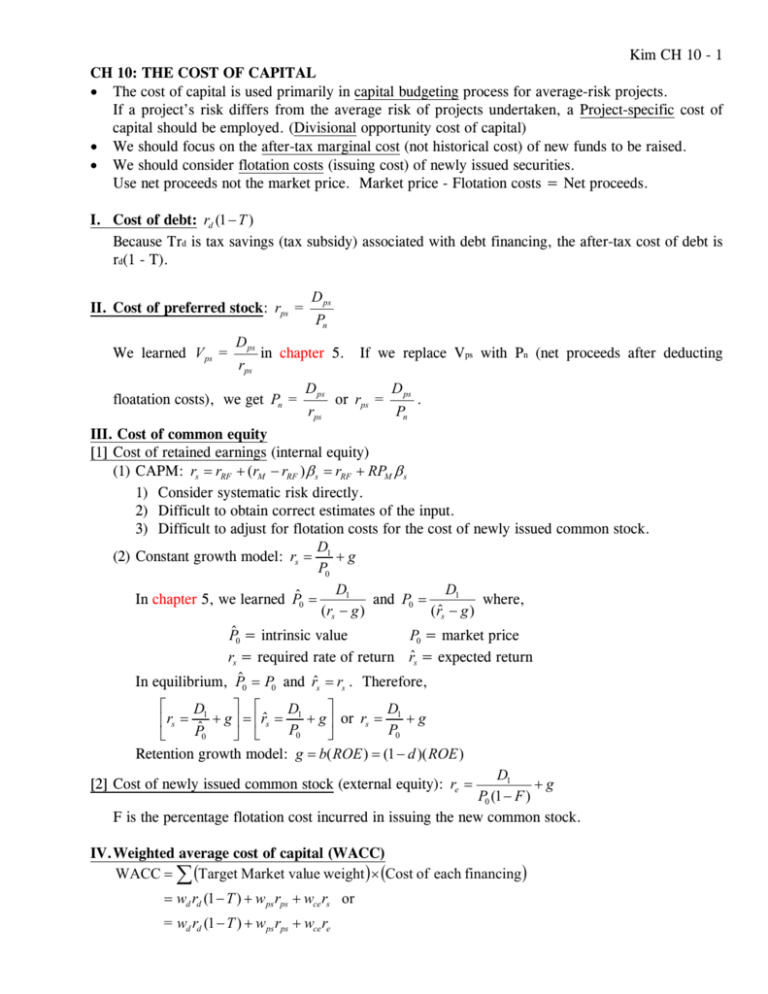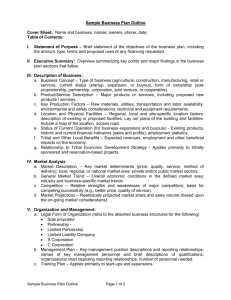Kim CH 10 - 1 CH 10: THE COST OF CAPITAL • The cost of capital
advertisement

Kim CH 10 - 1 CH 10: THE COST OF CAPITAL • The cost of capital is used primarily in capital budgeting process for average-risk projects. If a project’s risk differs from the average risk of projects undertaken, a Project-specific cost of capital should be employed. (Divisional opportunity cost of capital) • We should focus on the after-tax marginal cost (not historical cost) of new funds to be raised. • We should consider flotation costs (issuing cost) of newly issued securities. Use net proceeds not the market price. Market price - Flotation costs = Net proceeds. I. Cost of debt: rd (1 − T ) Because Trd is tax savings (tax subsidy) associated with debt financing, the after-tax cost of debt is rd(1 - T). II. Cost of preferred stock: rps = We learned V ps = D ps rps D ps Pn in chapter 5. floatation costs), we get Pn = D ps rps If we replace Vps with Pn (net proceeds after deducting or rps = D ps Pn . III. Cost of common equity [1] Cost of retained earnings (internal equity) (1) CAPM: rs = rRF + (rM − rRF ) β s = rRF + RPM β s 1) Consider systematic risk directly. 2) Difficult to obtain correct estimates of the input. 3) Difficult to adjust for flotation costs for the cost of newly issued common stock. D (2) Constant growth model: rs = 1 + g P0 D1 D1 In chapter 5, we learned Pˆ0 = and P0 = where, (rs − g ) (rˆs − g ) P = market price P$ = intrinsic value 0 0 rs = required rate of return r̂s = expected return In equilibrium, P$ = P and rˆ = r . Therefore, 0 0 s s ⎡ ⎤ ⎡ ⎤ D1 D1 D + g ⎥ or rs = 1 + g ⎢rs = ˆ + g ⎥ = ⎢rˆs = P0 P0 P0 ⎦ ⎣ ⎦ ⎣ Retention growth model: g = b( ROE ) = (1 − d )( ROE ) D1 +g P0 (1 − F ) F is the percentage flotation cost incurred in issuing the new common stock. [2] Cost of newly issued common stock (external equity): re = IV. Weighted average cost of capital (WACC) WACC = ∑ (Target Market value weight ) × (Cost of each financing ) = wd rd (1 − T ) + w ps rps + wce rs or = wd rd (1 − T ) + w ps rps + wce re Kim CH 10 - 2 are the weights for debt, preferred stock, and common where wd, wps, and wce equity. Three types (components) of financing: debt (d), preferred stock (ps), and common equity (ce). • • Weights should be the target weights NOT the actual or historical weights. Weights should be the market value weights NOT the book value weights. V. Marginal cost of capital (MCC): the weighted average cost of each new dollar of capital raised at the margin. As companies raise larger and larger amount of new capital, the cost of each capital component will rise. [1] The firm uses the common equity coming from retained earnings until they have been used up, and then from the issuance of new common stock (which is more expensive). [2] The costs of debt and preferred stock will increase due to an increase in level of risk perceived by investors. VI. Marginal cost of capital schedule (MCC schedule): The WACC will rise as total financing increases. This increasing WACC is called by the MCC (Marginal Cost of Capital) schedule. VII. Break point: How much total financing can be raised before the cost of one capital component increases? A break point will occur whenever the cost of one of the financing component (type) rises. A break point is the dollar value of new capital that can be raised before an increase in the firm’s WACC occurs. Dollar amount of lower cost capital of a given financing type j BPj = Weight for financing type j [Example] Retained earnings = $75.8 million rs = 0.134 New common stock re = 0.14 wce = 0.53 $75.8 million BPce = = $143,018,867.9 0.53 VIII. Steps [1] Identify all break points. [2] Identify the intervals between break points. [3] Calculate WACC in each interval. IX. Investment opportunity schedule (IOS) A graph of the firm’s investment opportunities (projects) ranked in descending order of the project’s rate of return. X. Combining the MCC and IOS schedules • The firm should accept a project if the project's IRR exceeds the cost of the capital. • Optimal capital budget is the dollar amount of capital raised for accepted projects. • The WACC at the point where the IOS schedule intersects the MCC schedule is the cost of capital the firm would use to evaluate average-risk projects. Kim CH 10 - 3 Percent MCC Correct r used in the capital budgeting process IOS Optimal capital budget Total amount of new capital raised and Invested XI. Assumptions [1] All projects are independent [2] All projects' risks are all equal to the entire portfolio of the firm's assets. XII. Divisional and Project-specific cost of capital The CAPM requires that all projects earn at least the rate of return required by the market on projects of equivalent risk. Each project has its own WACC because each project has different risk. The firm WACC is only an average cost of capital appropriate for the entire portfolio of corporate assets. It is not appropriate for an individual project. Returns SML Region 2 Firm’s WACC Region 1 If we incorrectly use firm WACC in capital budgeting, Region 1: Project β < firm β Reject many good low-risk projects. Region 2: Project β > firm β Accept many poor high-risk projects. Project β Firm β !!!!Copy 6th Pages 182-189!!!! Kim CH 10 - 4 ****************************************************************** [PROBLEM] Hawley Enterprises has the following capital structure, which it consider to be optimal under present and forecasted conditions: Debt 45% Common equity: 55% For the coming year, management expects EAC of $2.5 million. Hawley’s past dividend policy of paying out 60 percent of EAC will continue. Present commitments from its banks will allow Hawley to borrow according to the following schedule: Loan Amount Interest Rate $0 to $500,000 9% $500,001 to $900,000 11% $900,001 and above 13% The company’s average tax rate is 40percent, the current market price of its stock is $22 per share, its last dividend was $2.20 per share, and the expected growth rate is 5 percent. External equity (new common) can be sold at a flotation cost of 10 percent. Hawley has the following investment opportunities for the next year: Project Cost Rate of return 1 $675,000 16% 2 900,000 15% 3 375,000 14% 4 562,500 12% 5 750,000 11% Management asks you to help determine which projects (if any) should be undertaken. ****************************************************************** Kim CH 10 - 5 Solution (1) Common equity $1.5M Cash Dividend ($2.5M x 0.6) EAC ($2.5M) $1M ΔRE ($2.5M x 0.4) $1M = 1,818,181. 8 1 0.55 1) Cost of retained earnings D 2.20(1 + 0.05) rs = 1 + g = + 0.05 = 0.155 P0 22 2) Cost of newly issued common stock D1 2.20(1 + 0.05) rs = +g = + 0.05 = 0.1 6 = 0.166666666 P0 (1 − F) 22(1 - 0.10) BP = (2) Debt $500,000 = 1,111,111. 1 1 0.45 $900,000 BP = = 2,000,000.00 0.45 1) Cost of debt: rd(1-T) 0.09(1-0.40)=0.054 0.11(1-0.40)=0.066 0.13(1-0.40)=0.078 BP = (3) Break points and intervals Int#1 Int#2 Int#3 Int#4 $Total Financing 1,111,111.11 (debt) 1,818,181.81 (CE) 0.155 2,000,000 (Debt) 0.16666666 Cost of CE 0.054 0.066 0.078 Cost of Debt (4) WACC 1) Interval #1 ($0 - $1,111,111.11): 2) Interval #2 ($1,111,111.11 - $1,818,181.81): 3) Interval #3 ($1,818,181.81 - $2,000,000): 4) Interval #4 (Over $2,000,000): 0.55x0.155 + 0.45x0.054 = 0.10955 0.55x0.155 + 0.45x0.066 = 0.11495 0.55x0.166666666 + 0.45x0.066 = 0.121366666 0.55x0.166666666 + 0.45x0.078 = 0.126766666 Kim CH 10 - 6 (5) IOS Project 1 2 3 4 5 Rate of return 16% 15% 14% 12% 11% Cost $675,000 $900,000 $375,000 $562,500 $750,000 Cumulative Cost $675,000 $1,575,000 $1,950,000 $2,512,500 $3,262,500 16% 15% 14% 13% 0.126766666 0.12136666 0.11495 12% 0.10955 11% 10% $Total Financing $1M $2M $3M (6) Conclusions 1) Accept Project 1, Project 2, and Project 3 because the rates of return are higher than the costs. 2) Reject Project 4 and Project 5 because the costs are higher than the rates of return. 3) Correct cost of capital used in the capital budgeting process = 12.136666666% 4) Optimal capital budget is $1,950,000 to accept Project 1, Project 2, and Project 3. Common equity financing: $1,950,000 x 0.55 = $1,072,500 Debt financing: $1,950,000 x 0.45 = $877,500








